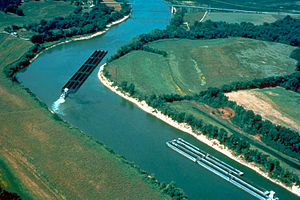Cumberland River
| Cumberland River | |
|---|---|
 | |
 | |
| Physical characteristics | |
| Mouth | Ohio River |
| Length | 687 mi (1,106 km) |


The Cumberland River is an important waterway in the Southern United States. It is 678 miles (1,106 km) long. It starts in Letcher County in eastern Kentucky on the Cumberland Plateau, flows through southeastern Kentucky before crossing into northern Tennessee, and then curves back up into western Kentucky before draining into the Ohio River at Smithland, Kentucky. The Cumberland is one of three major Kentucky rivers with headwaters in this county. The others are the Kentucky River and the Big Sandy River.
In 1748, Dr. Thomas Walker led a party of hunters across the Appalachian Mountains from Virginia. Walker, a Virginian, was an explorer and surveyor of renown. He gave the name "Cumberland" to the lofty range of mountains his party crossed, in honor of Prince William Augustus, Duke of Cumberland whose name became popular in America after the Battle of Culloden (Stewart, 1967). Walker's party pursued their journey by way of the Cumberland Gap into what is today Kentucky. Finding a beautiful mountain stream flowing across their course they called it the "Cumberland River." Walker's journal entry for April 17, 1750, reads in part: "I went down the creek a-hunting, and found that it went into a river about a mile below our camp. This, which is Flat Creek and some other join'd, I called Cumberland River."
Previous to Walker's trip, the Cumberland River had been called Warioto by Native Americans and Shauvanon by French traders. The river was also known as the Shawnee River (or Shawanoe River) for years after Walker's trip. [1]
Important first as a passage for hunters and settlers, the Cumberland River also supported later riverboat trade which reached to the Ohio and Mississippi Rivers. Villages, towns and cities were located at landing points along its banks. Through the middle of the 19th century, settlers depended on rivers for trading and travel.
The Cumberland River is a wild river above the headwaters of Lake Cumberland. Cumberland Falls, a 68-foot waterfall on this section of river, is one of the largest waterfalls in the eastern United States, and the only place in the Western Hemisphere where a moonbow can be seen. Most of the river below Lake Cumberland's Wolf Creek Dam is navigable because of a number of locks and dams. A 90 mile section of its Big South Fork is protected by the National Park Service as Big South Fork National River and Recreation Area.
Dams at various locations of the Cumberland River have created large reservoirs for recreation such as Lake Barkley in western Kentucky and Lake Cumberland (the deepest lake in the Tennessee and Cumberland river valleys) in southern Kentucky. Cordell Hull and Old Hickory Lake to the east of Nashville and Cheatham Lake to the west. Laurel Lake, on the Laurel River in southern Kentucky, the Dale Hollow Reservoir on the Obey River in northeast middle Tennessee, and Percy Priest Lake on the Stones River in Nashville are each created by dams just upstream from their respective confluence with the Cumberland River.
Several American Civil War battles occurred near the Cumberland River, including the battle for Fort Donelson. The river's name has been used to name the Union Army of the Cumberland and several U.S. Navy ships have been called USS Cumberland.
References
- Albright, Edward. "Early History of Middle Tennessee". (1908).
- Stewart, George R. "Names on the Land". (Boston: 1967) (See George R. Stewart)
- Arthur Benke & Colbert Cushing, "Rivers of North America". Elsevier Academic Press, 2005 ISBN 0-12-088253-1
